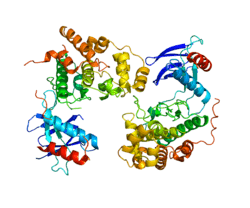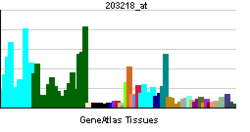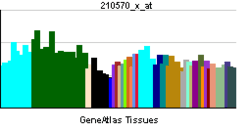Mitogen-activated protein kinase 9
Mitogen-activated protein kinase 9 is an enzyme that in humans is encoded by the MAPK9 gene.[1]
The protein encoded by this gene is a member of the MAP kinase family. MAP kinases act as an integration point for multiple biochemical signals, and are involved in a wide variety of cellular processes such as proliferation, differentiation, transcription regulation and development. This kinase targets specific transcription factors, and thus mediates immediate-early gene expression in response to various cell stimuli. It is most closely related to MAPK8, both of which are involved in UV radiation-induced apoptosis, thought to be related to the cytochrome c-mediated cell death pathway. This gene and MAPK8 are also known as c-Jun N-terminal kinases. This kinase blocks the ubiquitination of tumor suppressor p53, and thus it increases the stability of p53 in nonstressed cells. Studies of this gene's mouse counterpart suggest a key role in T-cell differentiation. Four alternatively spliced transcript variants encoding distinct isoforms have been reported.[2]
Interactions
Mitogen-activated protein kinase 9 has been shown to interact with:
References
- ↑ Kallunki T, Su B, Tsigelny I, Sluss HK, Derijard B, Moore G, Davis R, Karin M (January 1995). "JNK2 contains a specificity-determining region responsible for efficient c-Jun binding and phosphorylation". Genes Dev 8 (24): 2996–3007. doi:10.1101/gad.8.24.2996. PMID 8001819.
- ↑ "Entrez Gene: MAPK9 mitogen-activated protein kinase 9".
- ↑ Saleem A, Datta R, Yuan ZM, Kharbanda S, Kufe D (December 1995). "Involvement of stress-activated protein kinase in the cellular response to 1-beta-D-arabinofuranosylcytosine and other DNA-damaging agents". Cell Growth Differ. 6 (12): 1651–8. PMID 9019171.
- ↑ Kharbanda S, Saleem A, Shafman T, Emoto Y, Taneja N, Rubin E, Weichselbaum R, Woodgett J, Avruch J, Kyriakis J (August 1995). "Ionizing radiation stimulates a Grb2-mediated association of the stress-activated protein kinase with phosphatidylinositol 3-kinase". J. Biol. Chem. 270 (32): 18871–4. doi:10.1074/jbc.270.32.18871. PMID 7642542.
- ↑ 5.0 5.1 Yasuda J, Whitmarsh AJ, Cavanagh J, Sharma M, Davis RJ (October 1999). "The JIP group of mitogen-activated protein kinase scaffold proteins". Mol. Cell. Biol. 19 (10): 7245–54. PMC 84717. PMID 10490659.
- ↑ Whitmarsh AJ, Cavanagh J, Tournier C, Yasuda J, Davis RJ (September 1998). "A mammalian scaffold complex that selectively mediates MAP kinase activation". Science 281 (5383): 1671–4. doi:10.1126/science.281.5383.1671. PMID 9733513.
- ↑ Ito M, Yoshioka K, Akechi M, Yamashita S, Takamatsu N, Sugiyama K, Hibi M, Nakabeppu Y, Shiba T, Yamamoto KI (November 1999). "JSAP1, a novel jun N-terminal protein kinase (JNK)-binding protein that functions as a Scaffold factor in the JNK signaling pathway". Mol. Cell. Biol. 19 (11): 7539–48. PMC 84763. PMID 10523642.
- ↑ Kelkar N, Gupta S, Dickens M, Davis RJ (February 2000). "Interaction of a mitogen-activated protein kinase signaling module with the neuronal protein JIP3". Mol. Cell. Biol. 20 (3): 1030–43. doi:10.1128/mcb.20.3.1030-1043.2000. PMC 85220. PMID 10629060.
- ↑ Hu MC, Qiu WR, Wang YP (November 1997). "JNK1, JNK2 and JNK3 are p53 N-terminal serine 34 kinases". Oncogene 15 (19): 2277–87. doi:10.1038/sj.onc.1201401. PMID 9393873.
- ↑ Lin Y, Khokhlatchev A, Figeys D, Avruch J (December 2002). "Death-associated protein 4 binds MST1 and augments MST1-induced apoptosis". J. Biol. Chem. 277 (50): 47991–8001. doi:10.1074/jbc.M202630200. PMID 12384512.
- ↑ Maekawa M, Nishida E, Tanoue T (October 2002). "Identification of the Anti-proliferative protein Tob as a MAPK substrate". J. Biol. Chem. 277 (40): 37783–7. doi:10.1074/jbc.M204506200. PMID 12151396.
External links
Further reading
- Davis RJ (2000). "Signal transduction by the JNK group of MAP kinases". Cell 103 (2): 239–52. doi:10.1016/S0092-8674(00)00116-1. PMID 11057897.
- Freedman BD, Liu QH, Del Corno M, Collman RG (2004). "HIV-1 gp120 chemokine receptor-mediated signaling in human macrophages". Immunol. Res. 27 (2–3): 261–76. doi:10.1385/IR:27:2-3:261. PMID 12857973.
- Lee C; Liu QH; Tomkowicz B et al. (2004). "Macrophage activation through CCR5- and CXCR4-mediated gp120-elicited signaling pathways". J. Leukoc. Biol. 74 (5): 676–82. doi:10.1189/jlb.0503206. PMID 12960231.
- Denys H; Desmet R; Stragier M et al. (1978). "Cystitis emphysematosa". Acta urologica Belgica 45 (4): 327–31. PMID 602896.
- Dawson SJ, White LA (1992). "Treatment of Haemophilus aphrophilus endocarditis with ciprofloxacin". J. Infect. 24 (3): 317–20. doi:10.1016/S0163-4453(05)80037-4. PMID 1602151.
- Livingstone C, Patel G, Jones N (1995). "ATF-2 contains a phosphorylation-dependent transcriptional activation domain". EMBO J. 14 (8): 1785–97. PMC 398272. PMID 7737129.
- Sluss HK, Barrett T, Dérijard B, Davis RJ (1994). "Signal transduction by tumor necrosis factor mediated by JNK protein kinases". Mol. Cell. Biol. 14 (12): 8376–84. PMC 359376. PMID 7969172.
- Gille H, Strahl T, Shaw PE (1996). "Activation of ternary complex factor Elk-1 by stress-activated protein kinases". Curr. Biol. 5 (10): 1191–200. doi:10.1016/S0960-9822(95)00235-1. PMID 8548291.
- Chu Y; Solski PA; Khosravi-Far R et al. (1996). "The mitogen-activated protein kinase phosphatases PAC1, MKP-1, and MKP-2 have unique substrate specificities and reduced activity in vivo toward the ERK2 sevenmaker mutation". J. Biol. Chem. 271 (11): 6497–501. doi:10.1074/jbc.271.11.6497. PMID 8626452.
- Bocco JL; Bahr A; Goetz J et al. (1996). "In vivo association of ATFa with JNK/SAP kinase activities". Oncogene 12 (9): 1971–80. PMID 8649858.
- Gupta S; Barrett T; Whitmarsh AJ et al. (1996). "Selective interaction of JNK protein kinase isoforms with transcription factors". EMBO J. 15 (11): 2760–70. PMC 450211. PMID 8654373.
- Kallunki T, Deng T, Hibi M, Karin M (1997). "c-Jun can recruit JNK to phosphorylate dimerization partners via specific docking interactions". Cell 87 (5): 929–39. doi:10.1016/S0092-8674(00)81999-6. PMID 8945519.
- Jabado N; Pallier A; Jauliac S et al. (1997). "gp160 of HIV or anti-CD4 monoclonal antibody ligation of CD4 induces inhibition of JNK and ERK-2 activities in human peripheral CD4+ T lymphocytes". Eur. J. Immunol. 27 (2): 397–404. doi:10.1002/eji.1830270209. PMID 9045910.
- Janknecht R, Hunter T (1997). "Convergence of MAP kinase pathways on the ternary complex factor Sap-1a". EMBO J. 16 (7): 1620–7. doi:10.1093/emboj/16.7.1620. PMC 1169766. PMID 9130707.
- Fukunaga R, Hunter T (1997). "MNK1, a new MAP kinase-activated protein kinase, isolated by a novel expression screening method for identifying protein kinase substrates". EMBO J. 16 (8): 1921–33. doi:10.1093/emboj/16.8.1921. PMC 1169795. PMID 9155018.
- Chow CW; Rincón M; Cavanagh J et al. (1997). "Nuclear accumulation of NFAT4 opposed by the JNK signal transduction pathway". Science 278 (5343): 1638–41. doi:10.1126/science.278.5343.1638. PMID 9374467.
- Hu MC, Qiu WR, Wang YP (1997). "JNK1, JNK2 and JNK3 are p53 N-terminal serine 34 kinases". Oncogene 15 (19): 2277–87. doi:10.1038/sj.onc.1201401. PMID 9393873.
- Lannuzel A; Barnier JV; Hery C et al. (1998). "Human immunodeficiency virus type 1 and its coat protein gp120 induce apoptosis and activate JNK and ERK mitogen-activated protein kinases in human neurons". Ann. Neurol. 42 (6): 847–56. doi:10.1002/ana.410420605. PMID 9403476.
- Fuchs SY; Xie B; Adler V et al. (1998). "c-Jun NH2-terminal kinases target the ubiquitination of their associated transcription factors". J. Biol. Chem. 272 (51): 32163–8. doi:10.1074/jbc.272.51.32163. PMID 9405416.
This article incorporates text from the United States National Library of Medicine, which is in the public domain.
| |||||||||||||||||||||||||||||||||||||||||||||||||||||||||||||||||||||||||||||||||||||||||||||||||||||||||||||||||||||||||||||||||||||||||||||||||||||||||||||||||


